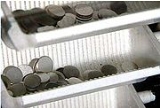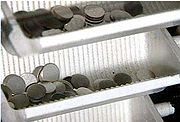
Planchet
Encyclopedia

A planchet is a round metal disk that is ready to be struck as a coin
Coin
A coin is a piece of hard material that is standardized in weight, is produced in large quantities in order to facilitate trade, and primarily can be used as a legal tender token for commerce in the designated country, region, or territory....
. An older word for planchet is flan. They are also referred to as blanks.
History
The preparation of the flan or planchet has varied over the years. In ancient times, the flan was heated before striking because the metal that the coin dies were made out of was not as hard as dies today, and the dies would have worn faster and broken sooner had the flan not been heated to a high temperature to soften it.Modern striking
Today's dies are made from hardened steelHardened steel
The term hardened steel is often used for a medium or high carbon steel that has been given the heat treatments of quenching followed by tempering. The quenching results in the formation of metastable martensite, the fraction of which is reduced to the desired amount during tempering. This is the...
, and the presses use many thousands of pounds
Pound-force
The pound force is a unit of force in some systems of measurement including English engineering units and British gravitational units.- Definitions :...
of force to strike coins (varying according to the size of the coin and the complexity and relief of the design). In addition, today's coins have much lower relief than ancient coins. Because of this, the planchet no longer needs to be heated immediately before striking, although it is annealed
Annealing (metallurgy)
Annealing, in metallurgy and materials science, is a heat treatment wherein a material is altered, causing changes in its properties such as strength and hardness. It is a process that produces conditions by heating to above the recrystallization temperature, maintaining a suitable temperature, and...
by heating and slow cooling which softens the coin.
Preparation

Mint (coin)
A mint is an industrial facility which manufactures coins for currency.The history of mints correlates closely with the history of coins. One difference is that the history of the mint is usually closely tied to the political situation of an era...
itself. These flat rolls or sheets of metal are then punched out into round blanks that are a little larger than the coin being struck. The blanks are then subjected to an annealing process that softens the metal through heating to approximately 750 degrees Celsius
Celsius
Celsius is a scale and unit of measurement for temperature. It is named after the Swedish astronomer Anders Celsius , who developed a similar temperature scale two years before his death...
(1400 degrees Fahrenheit
Fahrenheit
Fahrenheit is the temperature scale proposed in 1724 by, and named after, the German physicist Daniel Gabriel Fahrenheit . Within this scale, the freezing of water into ice is defined at 32 degrees, while the boiling point of water is defined to be 212 degrees...
) and are then slowly air cooled. They are then washed to remove residue from the annealing process and dried. The blanks then go through an upsetting mill that raises the rim on the edge of the coin.
Completion
Finally, the planchet is struck. After striking, it becomes a coin and is no longer a planchet. Occasionally, a planchet will escape the mint without having been struck. This is a blank planchet error, and is usually worth a few dollars for modern coins. Occasionally, blank planchets can be rare and valuable, such is the case for Morgan DollarMorgan Dollar
The Morgan dollar was a United States dollar coin minted intermittently from 1878 to 1921. It was the first standard silver dollar minted since production of the previous design, the Seated Liberty dollar, ceased due to the passage of the Fourth Coinage Act, an act which also ended the free coining...
blank planchets, although authentication is highly recommended for such pieces as they would be fairly easy to counterfeit.
External links
- How coins are minted An extensive description of the minting process through the ages
- http://www.winsociety.org/newsletter/news_archive/rhart.html
- http://www.usmint.gov/faqs/circulating_coins/index.cfm?flash=yes&action=coins (flash required)
- http://www.coinworld.com/NewCollector/MintingProcess.asp

